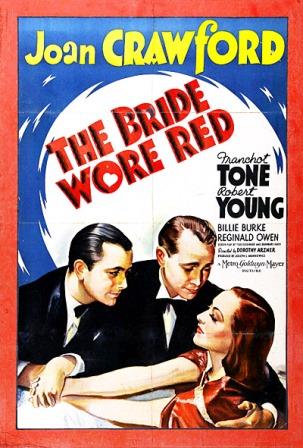 I want you to marry her, and I want my love to haunt you…to make you lie awake at night, to burn your heart, to make you sick with pain! I want you to think of me and to ache for me. I want never to see you again! – Anni Pavlovitch (Joan Crawford)
I want you to marry her, and I want my love to haunt you…to make you lie awake at night, to burn your heart, to make you sick with pain! I want you to think of me and to ache for me. I want never to see you again! – Anni Pavlovitch (Joan Crawford)
A rather morose blend of Cinderella and My Fair Lady brings us 1937’s The Bride Wore Red, the film that ultimately got star Joan Crawford the dreaded label of box office poison which she worked so hard to shirk as her career continued.
Wonderfully filmed in true overwhelming MGM fashion, it is clear that little if any expense was spared during the production by director Dorothy Arzner, who successfully transitioned from silent into sound films focused primarily on somber women’s issues. There’s gowns by Adrian everywhere, opulent set pieces and even little leitmotif musical themes for not only Crawford, but also for her costars Franchot Tone and Robert Young. It’s a wondrous spectacle to behold.
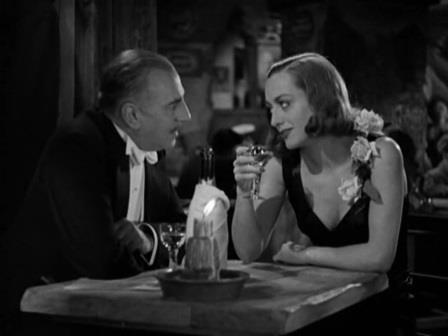 Joan Crawford, filling in for Luise Ranier who dropped out of production, is cabaret dancer Anni Pavlovitch. Though never explicitly stated, it’s clear she’s also a prostitute with a resulting particularly jaded view of love. She meets Count Armalia (George Zucco) who sets her up as one of the social highbrows at a mountain retreat for two weeks with all expenses paid so she will fit right in. Will all the trappings no one will know she’s a lowly cabaret dancer.
Joan Crawford, filling in for Luise Ranier who dropped out of production, is cabaret dancer Anni Pavlovitch. Though never explicitly stated, it’s clear she’s also a prostitute with a resulting particularly jaded view of love. She meets Count Armalia (George Zucco) who sets her up as one of the social highbrows at a mountain retreat for two weeks with all expenses paid so she will fit right in. Will all the trappings no one will know she’s a lowly cabaret dancer.
All goes well as she gets to town after a ride on a donkey cart with Giulio the postman (Franchot Tone). Once at the resort, she immediately falls in love with all the servants, extravagant meals, and fancy clothes that her benefactor has provided for her. Before she’s even gotten started she’s determined to do whatever she can to preserve this new lifestyle. Shortly thereafter she meets Rudi Pal (Robert Young) along with the rest of his party, which includes his fiance Maddelana (Lynne Carver) and Contessa di Meina (Billie Burke).
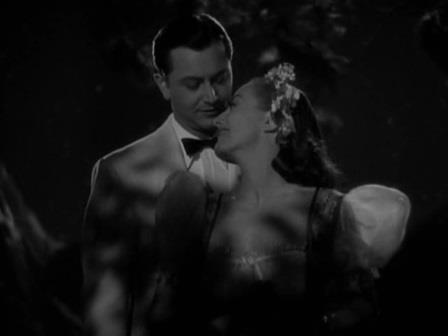 Immediately she decides to marry Rudi, regardless of his current status with Maddelana. And here also starts a game of see-saw which lasts the remainder of the film, with Joan alternating with increasingly cloying and fawning insincerity with Rudi and his circle and open snarkiness tinged with softer moments with Guilio. All along she’s anxious that someone will realize that she’s not who she’s pretending to be and the charade will be over. Time is of the essence and she must seal the deal with Rudi.
Immediately she decides to marry Rudi, regardless of his current status with Maddelana. And here also starts a game of see-saw which lasts the remainder of the film, with Joan alternating with increasingly cloying and fawning insincerity with Rudi and his circle and open snarkiness tinged with softer moments with Guilio. All along she’s anxious that someone will realize that she’s not who she’s pretending to be and the charade will be over. Time is of the essence and she must seal the deal with Rudi.
This continues for a while but the Contessa is continually skeptical of Anni and works hard to determine her background, finally sending a telegram to the Count and asking where he knows her. He replies truthfully that he’s set her up as a bit of a joke and that she works in a cabaret. However, Giulio intercepts it (he’s also the telegraph operator) but doesn’t deliver it right away, hoping that Anni will open up on her own about her true past.
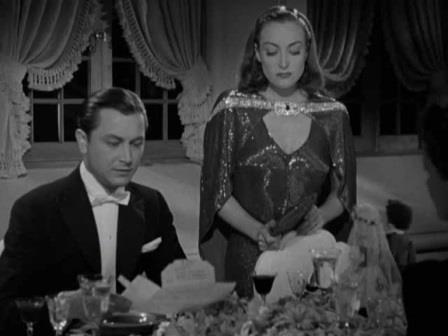 Knowing that time is running out, Anni finally gets Rudi to abandon his fiance as he proposes to her. Having learned that Guilio has the telegram sits for one last meal with the group before she and Rudi are to run off to Locarno to be wed. Then the telegram arrives, Anni is exposed and must leave the hotel in disgrace, where she again encounters Giulio with whom she presumably lives happily ever after.
Knowing that time is running out, Anni finally gets Rudi to abandon his fiance as he proposes to her. Having learned that Guilio has the telegram sits for one last meal with the group before she and Rudi are to run off to Locarno to be wed. Then the telegram arrives, Anni is exposed and must leave the hotel in disgrace, where she again encounters Giulio with whom she presumably lives happily ever after.
The Bride Wore Red isn’t a bad film, but it works only when taken as a single film outside of Joan’s filmography. The only downfall of the film is its rigorous adherence to what MGM had developed as its Joan Crawford formula. As evidenced by the box office poison she was labeled with as a result of the film, it’s clear that audiences and critics of the time were wanting something different. Thankfully over time the film’s viewed in at least a partially improved light.
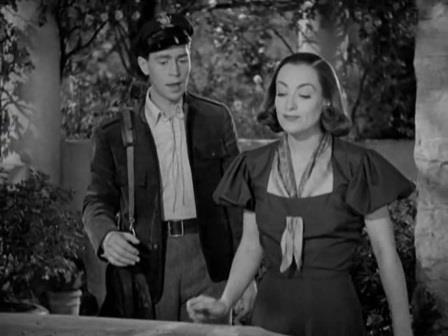 Though Joan Crawford has some strong scenes throughout the Bride Wore Red (particularly those where she’s alone in her suite), it’s hard to sympathize much with her character much. Even when she knows the gig is up, she hangs on, refusing to leave as she’s so smitten with the opulent but vapid life she’s led for the last two weeks. It’s clear she’s shallow enough to prefer physical things over love, as it’s clear that she and Rudi are definitely not a match in any way; not to mention that Crawford and Robert Young have little if any chemistry.
Though Joan Crawford has some strong scenes throughout the Bride Wore Red (particularly those where she’s alone in her suite), it’s hard to sympathize much with her character much. Even when she knows the gig is up, she hangs on, refusing to leave as she’s so smitten with the opulent but vapid life she’s led for the last two weeks. It’s clear she’s shallow enough to prefer physical things over love, as it’s clear that she and Rudi are definitely not a match in any way; not to mention that Crawford and Robert Young have little if any chemistry.
That said Rudi fares well when compared to the poor postman Giulio who she’s almost openly hostile too. Yet strangely the somewhat dopey but yet well-learned Giulio hangs in there and presumably gets the girl at the end. Played by then husband Franchot Tone, it’s hard not to sympathize with him and tell him to go find anyone….anyone but Anni. Anni’s a character that most anyone would agree likely doesn’t need a schmaltzy happy ending.
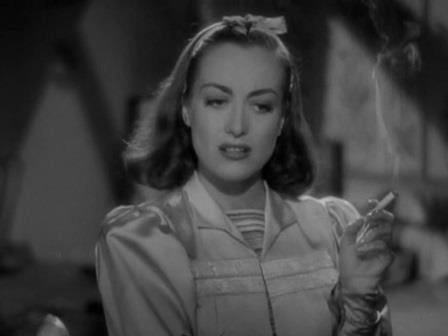 Among the nicer touches to the film are some of the smaller supporting players, including Anni’s maid in her suite, who used to work at the same cabaret as Anni does. Of course Anni’s unswayed by how much happier she is working cleaning all day. Humorous too is that many folks scattered throughout the film are cousins of Giulio who step quickly into and out of Anni’s story, but not after first providing some small aid to her.
Among the nicer touches to the film are some of the smaller supporting players, including Anni’s maid in her suite, who used to work at the same cabaret as Anni does. Of course Anni’s unswayed by how much happier she is working cleaning all day. Humorous too is that many folks scattered throughout the film are cousins of Giulio who step quickly into and out of Anni’s story, but not after first providing some small aid to her.
As another review has stated, The Bride Wore Red is a better film than most will give it credit for. However, it also depends on how much you like Crawford herself in yet another of her standard roles (at least during the MGM portion of her contract). If you’re a huge fan of hers, you’ll truly enjoy the film. Be warned, however, that this will wan proportionally with your fan level.